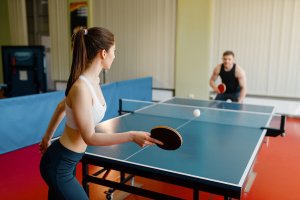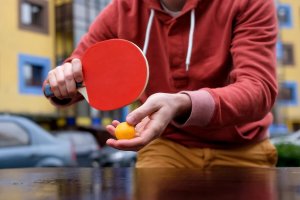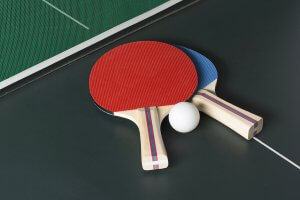Table Tennis as a Sport

The famous game of ping pong also known as table tennis is something people play a lot of at get-togethers with family and friends. You can find it at clubs, recreation centers, and even educational institutions too. It’s also, however, a real sport. Let’s learn more about it!
The similarities between this sport and tennis both as a game and in the name are no coincidence. Actually, most historians agree that it probably came about in England in the 19th century. It was likely a result of weather conditions that didn’t allow people to enjoy “real” tennis outside.
By the 1920s, people all over Europe and even India knew about table tennis; the English Association of Table Tennis was formed in 1926 as was the ITTF – the International Federation of Table Tennis.
With a headquarters in Lausanne, Switzerland, the association now has 222 associated organizations. It’s in charge of supervising international competitions such as the Table Tennis Championship World Tour. In addition to this, table tennis is a very popular sport in the Olympic Games as well as the Paralympic Games.
Basic rules of table tennis
Players can practice this sport individually or play with a partner in teams. In both cases, they use the same table to play. In either one of these types of games, the main objective is simply to pass the ball to the other side of the table. At the same time, you want to try to get your opponent to not hit it back.
In table tennis, players play sets – like in regular tennis – to 11 points. If there’s a tie with each team having ten points, they keep playing until there’s a difference of at least two points.

During games called doubles, the players on the same team have to take turns hitting the ball until a point is made. The serve is always made diagonally from the right side. The serving team varies every two points, or they take alternating turns depending on the specific situation.
Necessary equipment
Logically, you need three things to practice this sport: the ball, the racquets (also called paddles), and the table. Here we’ll talk about some specifics regarding each of them:
- Racquets: they can be any shape, size, and weight, but they have to be flat and rigid, and 85 percent of them must be wood. There must be a thin layer of rubber on the faces that hit the ball.
- Ball: its diameter is 40mm and it weighs 2.7 grams. It used to be smaller, but officials decided to enlarge it so people could see it on TV. This also made the ball slower so that the game would take longer.
- Table: the dimensions are 2.74 meters long and 1-52 meters wide. It should be 76 centimeters tall. It can be made out of any material, but the hight must be specific in order to participate in competitions. The white line that divides the surface must measure 3 millimeters. The borders are part of the surface, but the sides of the table outside of them are out of bounds.

Last but not least, the net: it should divide the space between the two sides and be held up by posts that are 15.25 centimeters tall. The top of the net should have that same height, and the bottom should almost touch the table. The net should be 1.83 meters wide.
Table tennis, a very complete sport
Now that we’ve detailed the parts of the game, the only thing left to do is remember why it’s a good game! First, your brain benefits: just by looking at it you can tell that it’s an activity that demands a lot of concentration and coordination.
Table tennis also tests your balance, the speed of your reaction time, and the mobility of your arms and hands. You also move your legs quite a bit, as you need to get your body in a good position to hit the ball – just like in regular tennis.
One thing is for certain: you’re in the presence of a game that, in addition to being really fun, is good for your physical well-being. As if that weren’t enough, it lets everyone from kids to older adults participate and play. Table tennis is a great game option all around!
The famous game of ping pong also known as table tennis is something people play a lot of at get-togethers with family and friends. You can find it at clubs, recreation centers, and even educational institutions too. It’s also, however, a real sport. Let’s learn more about it!
The similarities between this sport and tennis both as a game and in the name are no coincidence. Actually, most historians agree that it probably came about in England in the 19th century. It was likely a result of weather conditions that didn’t allow people to enjoy “real” tennis outside.
By the 1920s, people all over Europe and even India knew about table tennis; the English Association of Table Tennis was formed in 1926 as was the ITTF – the International Federation of Table Tennis.
With a headquarters in Lausanne, Switzerland, the association now has 222 associated organizations. It’s in charge of supervising international competitions such as the Table Tennis Championship World Tour. In addition to this, table tennis is a very popular sport in the Olympic Games as well as the Paralympic Games.
Basic rules of table tennis
Players can practice this sport individually or play with a partner in teams. In both cases, they use the same table to play. In either one of these types of games, the main objective is simply to pass the ball to the other side of the table. At the same time, you want to try to get your opponent to not hit it back.
In table tennis, players play sets – like in regular tennis – to 11 points. If there’s a tie with each team having ten points, they keep playing until there’s a difference of at least two points.

During games called doubles, the players on the same team have to take turns hitting the ball until a point is made. The serve is always made diagonally from the right side. The serving team varies every two points, or they take alternating turns depending on the specific situation.
Necessary equipment
Logically, you need three things to practice this sport: the ball, the racquets (also called paddles), and the table. Here we’ll talk about some specifics regarding each of them:
- Racquets: they can be any shape, size, and weight, but they have to be flat and rigid, and 85 percent of them must be wood. There must be a thin layer of rubber on the faces that hit the ball.
- Ball: its diameter is 40mm and it weighs 2.7 grams. It used to be smaller, but officials decided to enlarge it so people could see it on TV. This also made the ball slower so that the game would take longer.
- Table: the dimensions are 2.74 meters long and 1-52 meters wide. It should be 76 centimeters tall. It can be made out of any material, but the hight must be specific in order to participate in competitions. The white line that divides the surface must measure 3 millimeters. The borders are part of the surface, but the sides of the table outside of them are out of bounds.

Last but not least, the net: it should divide the space between the two sides and be held up by posts that are 15.25 centimeters tall. The top of the net should have that same height, and the bottom should almost touch the table. The net should be 1.83 meters wide.
Table tennis, a very complete sport
Now that we’ve detailed the parts of the game, the only thing left to do is remember why it’s a good game! First, your brain benefits: just by looking at it you can tell that it’s an activity that demands a lot of concentration and coordination.
Table tennis also tests your balance, the speed of your reaction time, and the mobility of your arms and hands. You also move your legs quite a bit, as you need to get your body in a good position to hit the ball – just like in regular tennis.
One thing is for certain: you’re in the presence of a game that, in addition to being really fun, is good for your physical well-being. As if that weren’t enough, it lets everyone from kids to older adults participate and play. Table tennis is a great game option all around!
All cited sources were thoroughly reviewed by our team to ensure their quality, reliability, currency, and validity. The bibliography of this article was considered reliable and of academic or scientific accuracy.
- Tenis de mesa. Wikipedia. https://es.wikipedia.org/wiki/Tenis_de_mesa
- Reglas de tenis de mesa. Special Olympics. http://media.specialolympics.org/soi/files/resources/SPANISH/SportsRules_Competitions/Tenis_de_Mesa.pdf
This text is provided for informational purposes only and does not replace consultation with a professional. If in doubt, consult your specialist.








